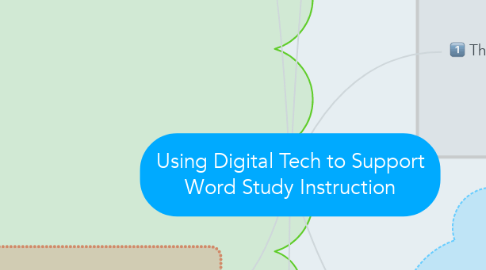
1. - Making it Happen
1.1. - teaches need to learn along with students
1.1.1. - promote reciprocal and joint ownership of vocab study
1.2. - invite students to reflect on how they use
2. - Appropriate technologies
2.1. - Does it align with Ontario curriculum?
2.2. - Does it address the needs of my students?
2.3. - Does it teach or does it just provide practice with what is known?
3. Apps for Junior-Intermediate
3.1. - Whirly Word
3.1.1. - All grades
3.1.2. $2.99
3.1.3. Student Collaboration
3.1.3.1. Discuss strategies to make as many words as possible
3.2. 8th Grade Vocab Quest
3.2.1. Free
3.2.2. Other Grades Available
3.2.3. Positives
3.2.3.1. - Various activitoes
3.2.3.1.1. Spelling, matching, True/False, categorizing
3.2.3.2. Rote Practice
3.2.3.3. Tracks Progress
3.2.3.4. Unlocking new wordlists
3.2.3.5. ENGAGING AND ADDICTICE
3.2.3.6. Minimal instruction required
3.2.3.6.1. Very intuitive and user friendly
3.2.4. Negatives
3.2.4.1. One user per device
3.2.4.1.1. can't switch between users/students/accounts
3.2.4.2. Can't track progress from a teacher account
3.2.4.2.1. Must observe student progress directly
3.3. Bluster
3.3.1. Free
3.3.2. Grade Levels 2-4
3.3.3. Positives
3.3.3.1. Single/Team/Vs. Modes
3.3.3.2. Matching words and investigating concepts of:
3.3.3.2.1. prefixes
3.3.3.2.2. Suffixes
3.3.3.2.3. synonyms
3.3.3.2.4. rhyming words
3.3.3.2.5. root words
3.3.3.2.6. homophones
3.3.3.2.7. adjectives
4. The Challenge
4.1. -Vocabulary Diminishing in today’s studentsv
4.2. Memorizing word lists and spelling dictation or writing out definitions does not fit with principles of 21st Century Learning
4.3. - Inequality in access to devices and apps
4.4. - Finding apps designed to build word study around intermediate instruction
5. Benefits of Digital Technologies
5.1. - students don’t all learn same word list
5.2. - engage in variety of games
5.3. - multi-touch screens appeal to kinesthetic learners
5.4. - devices used in small or whole group
5.5. - Feedback is immediate
5.6. - Rewards built into applications
5.7. - Students control pace of their learning
5.8. - Portability
6. My History/Rationale for Researching this Topic
6.1. I Need to incorporate improved and increased Word Study Instruction into my programming
6.1.1. Challenge is that it requires explicit instruction
6.1.2. I need tools that are engaging, require student directed opportunities for learning, ensure accountability, and allow for rich assessment
6.1.3. Technological tools are abundant for primary grades, and less so for junior, and even more less so for intermediate.

